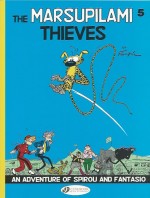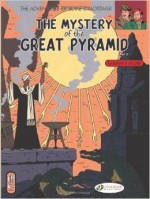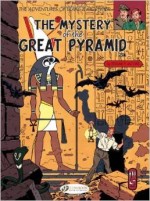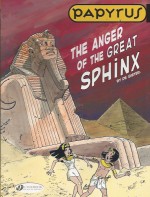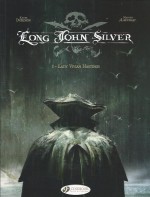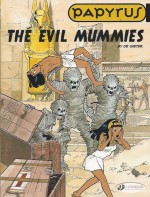
By Willy Lambil & Raoul Cauvin, translated by Erica Jeffrey (Cinebook)
ISBN: 978-1-84918-014-6
The glamour of the American Experience has fascinated Europeans virtually since the actual days of owlhoots and gunfighters.Hergé was a devotee, and the spectrum of memorable comics ranges from Italy’s Tex Willer to such French and Belgian classics as Blueberry and Lucky Luke,and even colonial dramas such as Pioneers of the New World or Milo Manara and Hugo Pratt’s Indian Summer.
‘Les Tuniques Bleues’ orThe Bluecoats began at the end of the 1960s, created by Louis “Salvé†Salvérius & Raoul Colvin – who has written every best-selling volume since. The strip was created to replace Lucky Luke when the laconic gunslinger defected from weekly anthology Spirou to rival comic Pilote, and his replacement swiftly became one of the most popular bande dessinée series on the Continent.
Salvé was a cartoonist of the Gallic big-foot/big-nose humour style, and when he died suddenly in 1972 his replacement, Willy “Lambil†Lambillotte slowly introduced a more realistic – although still comedic – illustrative manner. Lambil is Belgian, born in 1936 who, after studying Fine Art in college, joined publishing giant Dupuis as a letterer in 1952.
Born in 1938, scripter Raoul Cauvin is also Belgian and before joining Dupuis’ animation department in 1960 studied Lithography. He soon discovered his true calling – comedy writing – beginning his glittering and prolific career at Spirou.
In addition to Bluecoats he has written dozens of other long-running, award winning series including Cédric, Les Femmes en Blanc and Agent 212: more than 240 separate albums. Bluecoats alone has sold more than 15 million copies.
The sorry protagonists of the series are Sergeant Cornelius Chesterfield and Corporal Blutch: a pair of worthy fools in the manner of Laurel and Hardy, two hapless, ill-starred US cavalrymen posted to the wild frontier and various key points of mythic America.
The original format was single-page gags about an Indian-plagued Wild West fort, but with the second volume ‘Du Nord au Sud’ (‘North and South‘) the sad-sack soldiers went back East to fight in the American Civil War (this tale was rewritten in the 18th album ‘Blue rétro’ to describe how the chumps were drafted into the military during the war). All subsequent adventures, although ranging far beyond America and taking in a lot of genuine and thoroughly researched history, are set within the timeframe of the Secession conflict.
Blutch is your average whinging little-man-in-the street: work-shy, mouthy, devious and especially critical of the army and its inept commanders. Ducking, diving, even deserting whenever he can, he’s you or me – except sometimes he’s quite smart and heroic if no other easier option is available.
Chesterfield is a big burly man; a career soldier who has passionately bought into all the patriotism and esprit-de-corps of the Military. He is brave, never shirks his duty and wants to be a hero. He also loves his cynical little pal. They quarrel like a married couple, fight like brothers but simply cannot agree on the point and purpose of the horrendous war they are trapped in…
The Skyriders is the third album of the translated Cinebook series (chronologically the eighth French volume ‘Les cavaliers du ciel’) and opens with Chesterfield dashing to see his severely wounded pal. However, when he finds out Blutch has bribed a surgeon to declare him unfit for duty, the doughty sergeant goes through the roof…
Dragging Blutch back to the Front lines, the sergeant is just in time to be ordered by frankly quite mad Captain Stark to join him in another heroic cavalry charge against the massed Rebel infantry. The division has suffered a few losses recently so the unstoppable wave of valiant Union horsemen will number exactly three…
The assault naturally fails and the deranged officer is captured, with Blutch and the deeply shaken Chesterfield making it back to their own lines more by luck than skill.
The Union generals are in a bit of a tizzy. They have plenty of artillery and ground troops but are being worn down by the swift-moving Confederate cavalry’s harrying tactics. What they need is some method of observing the enemy’s position. Also, with the news of Stark’s capture comes the apprehension of his revealing key positions so the strategists are forced into trying something new.
All they need are a big balloon and a couple of expendable idiots…
The first observation flight is a huge success, so much so that the generals go up themselves after the principle is proved. Sadly, the Brass are far better fed than Blutch and Chesterfield and the wicker basket they crowd into proves painfully insufficient to their needs…
Broken and battered the big bosses choose to keep their bandaged feet on the ground from then on and our Bluecoats remain the army’s only airborne soldiery, enduring shot and shell as they spy on the enemy from above…
Stark meanwhile has not talked and the Confederates are beginning to lose traction in the battle. Correctly blaming the balloon for their reversals of fortune, the Gray commanders determine to destroy their aerostatic nemesis at all costs and a daring sortie on the observation post enables them to cut the balloon free from its moorings…
Adrift in the sky the hapless duo try everything to get down safely – consequently causing great consternation to the Rebel forces – before finally crashing to earth on top of their own already balloon-damaged commanding officers.
Ordered to rescue Captain Stark or face a firing squad, Chesterfield then devises an audacious, suicidal plan: using the balloon at night, he and Blutch will infiltrate the Confederate camp and bust their mad boss out.
What could possibly go wrong?
As always their manic midnight misadventures result in pain, humiliation and not a few explosions and, incredibly, victory and success – of a sort…
This is another hugely amusing anti-war saga targeting young and less cynical audiences. Historically authentic, always in good taste despite its uncompromising portrayal of violence, the attitudes expressed by the down-to-earth pair never make battle anything but arrant folly and, like the hilarious yet insanely tragic war-memoirs of Spike Milligan, these are comedic tales whose very humour makes the occasional moments of shocking verity doubly powerful and hard-hitting.
Fun, informative, beautifully realised and eminently readable, Bluecoats is the sort of war-story that appeals to the best, not worst, of the human spirit.
© Dupuis 1976 by Lambil & Cauvin. English translation © 2009 Cinebook Ltd. All rights reserved.

